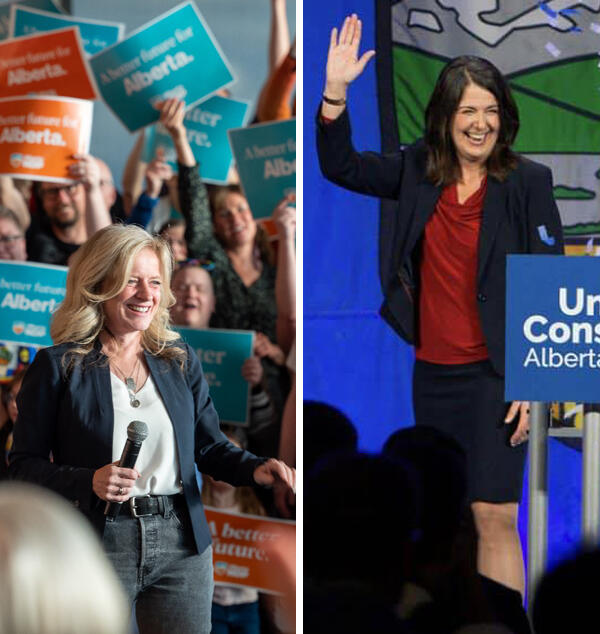June 12, 2023
2023 provincial election sheds light on the peculiarities of Alberta politics

With the 2023 Alberta provincial election in the rear view mirror, observers of just the electoral map could see the islands of orange in a sea of blue and deduce that the province has a rural-urban political divide.
However, a closer examination reveals three distinct voting regions: Calgary, Edmonton, and everywhere else. The United Conservative Party (UCP) won 63.4 per cent of votes outside of the two major city limits, while Edmonton voted 62.7 per cent in favour of the New Democratic Party (NDP) and Calgary saw an almost 50-50 split between the two electorally viable parties.
“A single-member plurality electoral system exaggerates geographically based differences,” says Dr. Lisa Young, PhD, a professor in the Department of Political Science at the University of Calgary.
“We look at the election results and say ‘oh, everything outside of the big cities is pretty much blue, so everyone must be conservative and everyone in Edmonton must be a New Democrat.’”
Cleavages and complexity
Even though the first past the post system doesn’t fully capture the over 30 per cent NDP support in rural ridings and the more than 30 per cent of Edmontonians who voted UCP, Young says the ability of both parties to easily win their respective strongholds shows some of the cleavages that exist.
There’s also lots of complexity when discussing the “everywhere outside of Calgary and Edmonton” vote, as that factors in a diversity of places and people, including smaller urban areas, Indigenous communities and mountain resort towns.

Alberta NDP Leader Rachel Notley, Alberta Premier and UCP leader Danielle Smith.
Facebook cover photos
The stark differences in voting between the three regions would’ve created challenges in governing for both parties, though Young says the NDP would have had the bigger struggle had they won.
“If the NDP had won, it would have been with basically no seats outside of urban areas, except for Banff-Kananaskis,” she says. “Given the political history of Alberta, their election would’ve been seen as illegitimate by some people outside of the cities.”
Young says being shut out of Edmonton will present some challenges for the UCP, but this isn’t uncommon in Canadian politics due to the electoral system. For example, the federal Liberal party has formed government for decades at a time despite holding little to no seats in the prairie provinces.
“Parties can find ways to manage the disparities,” says Young. “I think we’ll see one or two cabinet ministers from ridings adjacent to Edmonton who will be responsible for political outreach to the city.”
Securing seats in Calgary also ensures the UCP have urban voices in the caucus. Young says:
“Governing will be a challenge, but not an insurmountable one.”
What is also apparent from this election is the era of Alberta having two electorally competitive parties is here to stay. However, a move to the political middle by both parties means a third party may struggle to find footing.
“Political parties exist to win elections,” says Young. “So, if most voters locate themselves in the political centre, then parties have a strong incentive to move themselves to that political centre.”
Young says the NDP made a large shift to the centre, presenting themselves more as the old Progressive Conservative party. She says the UCP has had more of a struggle with this because the votes they needed to get to win the election were at the centre; however, this causes uprisings on the further right of the party, leading to splinter parties.
“The UCP has this balancing act that the NDP doesn’t have to manage,” she says.
Change a 'healthy thing' for democracy
In a democracy, two or more parties need to be viable to form government, and these parties will rotate in and out periodically. This keeps any party from having the belief that victory is inevitable.
“I think the idea that the government can change is a healthy thing for Alberta democracy,” says Young.
However, given the province’s history (which includes an over 40-year run of conservative parties forming government), Young says this is an idea not all Albertans are comfortable with.
This doesn’t mean Alberta was a dictatorship, though, as those conservative governments had to be highly responsive to public opinion to keep the dynasty alive.
“Even though there wasn’t a change of party in government, there was a democratic responsiveness that I think many Albertans view as the sort of normal state of democracy,” explains Young.
She says a lot of what we’re seeing in Alberta politics now is people getting comfortable with the idea of parties rotating in and out of office because, for many Albertans, there was a degree of comfort with the notion that the best form of government was one party that was sensitive to the public.
“It’s a very peculiar Alberta notion.”







